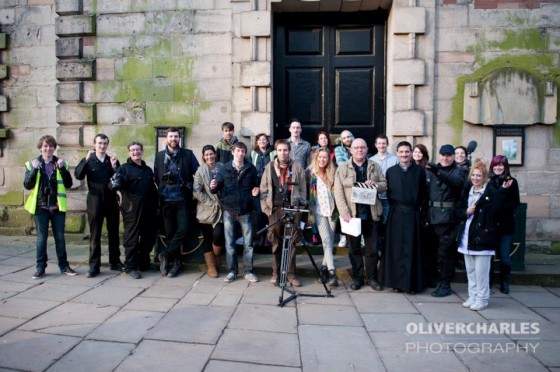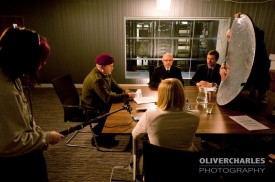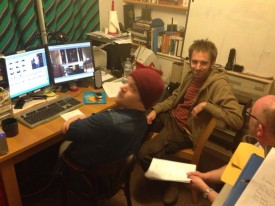I recently served as DP and postproduction supervisor on Fled, writer-director-producer Brendan O’Neill’s 2013 entry to the SciFi London 48hr Film Challenge. I asked him to share what he’s learnt from this and other film challenges he’s entered.
Brendan, this is not your first 48 hour film challenge. How many have you done before and what are the biggest things you learnt from them that you applied to this latest one?

I’ve done several now, 3 straight 48’s and 2 London Sci-Fi Society 48’s plus a time limited music video competition. My first ever film Black Widow was made for a local Birmingham competition called Film Dash in 2008. My second film What Goes Up Must Come Down was shot over a weekend for a non time limited competition run by Filmaka in the USA. I did a lot of ringing around and pre-production for this one as I wanted to really push the number of locations I could fit in. I found that by getting through to the right people, explaining who you are and what you want help with in a structured way can be very successful.
I made another 48 hour film Seconds Out for the same Film Dash competition in 2009 which placed 3rd out of 24 entries. I achieved some good production value by piggy backing a real event – a boxing contest held in a Birmingham hotel – with the help of the promoter who is also a local filmmaker.

The first really big production I put together was for Internalised – our first attempt at the London Sci-Fi Society’s 48 hour filmmaking competition in 2011. I spent 6 weeks pre-producing, location scouting, auditioning etc. and assembled a cast and crew of 50 to help us make the film. I also fed them all via an in-kind deal with local vegetarian catering company ChangeKitchen.
I suppose the first lesson I learnt on that was to not try to do it all on your own. The second being to be very careful who you take on board to help you and define clear roles and responsibilities for those involved. It can be difficult when you are working with volunteers but if you can convey the ambition and vision of what you are trying to do and have some previous track record then you can build feature size crews to help.
The shoot went very well but we were let down in post-production by not getting all the VFX/CGI we wanted into the competition version. You need to have your VFX/CGI team in the same place as your editors as it’s asking too much to render and then transmit the large files involved from remote locations when time is at a premium.

Our second attempt at the London Sci-Fi society 48 hour competition in 2012 was a World War II themed film called Around Again. We were looking for unusual locations with built-in production value and had identified a Midlands WWII era tunnel complex as a good location. We then found out that the person who controlled access to the tunnels also owned an extensive WWII costume wardrobe that had been used on Atonement and Band of Brothers so we dropped the tunnels location idea and went for battle/bunker scenes. The production value that all the great uniforms and replica / decommissioned firearms gave us was superb.
We were also very fortunate that our friend with the costume wardrobe Craig Leonard and his pyrotechnics colleague Matt Harley of Trinity VFX knew lots of German army / SS re-enactors who were more than happy to appear in the film. It shows the value of networking and being pro-active as that one contact expanded in all sorts of interesting ways to help us make a great looking film. I’m still reaping the benefits as Matt supplied the SWAT team outfits and arms for Fled as well as the GCHQ-esque second main location.
We were very surprised that the film didn’t shortlist but I think as producer if we’d had more clearly defined sci-fi elements in it then that would have helped.
Moving on to Fled, how much work had you put into writing and producing it before the challenge began on 10am on Saturday?
I spent about 6 weeks in pre-production. I hadn’t directed for a while so the first thing I did was do a smaller 48 hour competition which was running as part of the Stoke Your Fires festival.
[The next thing] I did was launch a crowd funding campaign via Indiegogo. I raised about £850 after fees so it helped a lot but it was a very labour intensive way of doing it with limited results. I didn’t have any donors who weren’t already linked to me in some way – mostly through Facebook.
Fortunately an established writer who I’d met twice at the Screenwriters Festival helped me a lot with an early and substantial individual donation. I think he likes my DIY attitude to getting films made. The previous year I also received a substantial donation via a Twitter relationship I had developed so it demonstrates that both traditional and social media based networking can’t be ignored.
Once the Indiegogo campaign was out of the way I worked on getting everything together. I had hoped for some substantial co-producer support but this didn’t really happen and the fact that I had to produce it nearly all myself definitely affected the amount of time I was able to spend on developing the script with my pal Dominic Carver as script editor. That said certain people such as Ella Carman, Matt Harley and stand in make-up artist Kerris Charles helped restore my battered faith in people.

I was surprised at how large the crew was (around 20). Do many hands make light work on a time-pressured project like this? Was there a degree of over-crewing in case some people didn’t turn up?
I’ve been on shoots where I haven’t had enough production assistants and runner/drivers so I tend to have some over-capacity just in case. The nature of the competition also means that it’s better to have more people to help in case the criteria you are given by the organisers are particularly difficult to handle. You are given a title, a line of dialogue and a prop/action by the organizers on the morning of the competition.
Although I did have some crew drop out prior to the competition I was able to replace them. My regular sound person dropped out with a foot injury so it was fortunate that Nicola Dale who was going to be post sound runner assisting Matt Katz and Joe Harper on the Sunday was able to step up to the mark and deliver great production sound with the help of Chantal Feliu Gurri on boom. Fortunately I’d met Nicola at a networking event a few weeks earlier and offered her the chance to come and work with some more experienced talent.
I do wish I had had some actor back-up however as someone dropped out on the Sunday morning pleading illness. It’s difficult to ask actors to turn up unpaid for what might only be extra type roles in a 5 minute film but it’s also VERY damaging when those who say they’ll do it drop out at short notice. It was especially galling as I’d written a role especially for this young man.
The consequence was that I had to bump someone who was only meant to be an extra into a role with lines which in my opinion definitely affected the quality of the film. For me Quality is King – with so many people having access to great technology you really have to try to ensure production values are as high as possible across the board in order to make your film stand out.
How did you approach integrating the challenge criteria (line of dialogue, prop and optional theme) into the film?
I try to build mechanisms into the script to deal with those things i.e. the wireless in the bunker scene in Around Again. That was there to help us field any difficult lines of dialogue we were given. Unfortunately last year we were given a very modern day line about the SEIS investment scheme so it was a bit clunky which is ironic given that it is a scheme that can help filmmakers raise finance!
We were lucky in that the criteria [this year] were very easy to integrate into the script.
Title: Fled
Prop: A key. A single key is put on a key ring with three near identical keys.

The initial idea was that [the entity] was an alien civilization that had had to flee some dying star millennia ago and had lain dormant on Mars until the first manned landings. This fitted the FLED title well. The key scene in the church echoes this when you can just make out the ethereal voices saying, “We can’t go back, we can’t go back.”
I was able to fit in the compulsory dialogue line as part of the NASA controllers trying to contact the Mars Explorer. The key on to keyring action/prop was easy and was the same one we got last year!
What was the schedule for the 48 hours in terms of when you started and finished filming, when the edit was locked, etc.?
At 10.00am DoP Neil Oseman and his gaffer Colin Smith went to the church location to pre-light and set up ready for filming whilst I awaited the criteria from the organisers. That way we could hit the ground running once we had a script finalized. The criteria arrived by text at about 11.15.

Fortunately the criteria given were very easy to integrate into my script so I arrived on set around 12.30 – 13.00 having picked up the VFX team at their hotel on the way. We needed to shoot the scenes they needed first in order to give them as much time as possible to work their magic.
I had planned to try and finish by 8pm so that the crew would be reasonably fresh for an early start the next day. I think we finished at around 21.15 and had a quick drink together before heading home. The next day we were all on set for 8.00am and set up for the first scenes quickly. I intended for us to finish around 2pm but there was a bit of creep to 3pm even though we trimmed and dropped some non essential scenes on the way. At both locations Neil and his regular gaffer Colin Smith, who was well assisted by Jay Somerville, did a brilliant job with the lighting.

Any plans to take part in future 48 hour challenges?
No. I don’t think so. I think I’ve done enough of them now. I want to either do some really high quality, well planned and developed festival oriented shorts or hopefully a first feature. I think 48 hour contests are a good discipline for young or emerging filmmakers as it gives you a focus and stress tests some of the relationships you might be developing. All a bit frantic but I’ve learnt a lot from them and come out a stronger and hopefully better filmmaker.
I think for this year’s contest just doing one high production value location per day and insisting that the VFX team were at the same post-production site as the edit team really made a difference. I was really fortunate to have really strong post-production edit and sound team and a great composer in Hans Hess who was at the ready to do the score. Hopefully people can see the difference those elements made in the quality of the competition version of the film.
Lastly I couldn’t have done it without Neil Oseman and a great international team of volunteer cast and crew. I hope that I’ll be able to work with them all again at some point. I’d particularly like to thank “King of the Indies” actor Michael Parle who came all the way from Ireland.
Thanks Brendan. You can visit Brendan’s blog at www.sticklebackproductions.co.uk. Scroll back to the top to see the film or click here to watch it on Vimeo.
Fled photography by Ian Jones – www.logic-media.co.uk – and Oliver Charles Woolley – www.facebook.com/olivercharlesphotography.
